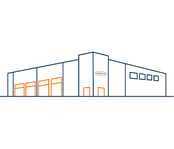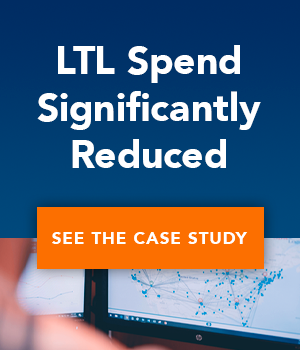
One of the biggest mistakes food and beverage manufacturers can make when it comes to their logistics is to just view their third-party logistics provider (3PL) as a cost of doing business rather than a success multiplier. Settling for less than leading-edge results has its own cost.
In culinary terms, it’s going for fast food when a fine dining experience could be had. In today’s competitive, service-centric marketplace, that can be bad for the health of your business and lead to missed opportunities for sensational performance.
Here are eight tips to help food and beverage manufacturers find and make the most of a 3PL—and establish a partnership that provides the competitive advantage with customers.
1 - Set Your 3PL up for Success
With many food and beverage manufacturers—especially those in a high growth phase—the emphasis when considering a new 3PL is on implementation and easy integration. The basic expectations are often overlooked.
Manufacturers should take the time to establish baseline expectations. You know what they say about assuming—it’s amazing how wide the gap between what a manufacturer expects and what a 3PL understands can be.
Communication is key. Only when a 3PL understands what is needed and expected, can they put a solution in place and design a program that succeeds on objectives.
2 – Examine a 3PL’s Ability to Establish Performance Metrics
Make sure a provider has what it takes to help your company establish meaningful performance metrics.
A 3PL needs to demonstrate a track record of successfully creating system-driven performance metrics and a process for translating them into continuous improvement initiatives.
The caveat is that starts with the manufacturer.
This goes back to setting up your 3PL for success. Food and beverage manufacturers should bring to the relationship an ability, capability and history of tracking KPIs. A 3PL needs to see your reporting details so they can reflect back on performance. You can’t track performance if you don’t have it. A lot of providers do back of the napkin goals, but that doesn’t give you a gauge of whether you’re winning or losing.
For the 3PL’s part, they should be able to demonstrate to you a system for tracking, monitoring and committing to KPIs.
Look for a provider’s successful experiences implementing programs for other food and beverage manufacturers. You want to see a true cadence of all parties coming together to talk strategy. You want transparent quarterly briefings that inspire action and improvement. Agility is important too. A 3PL’s ability to provide regular reporting, real-time accessibility or pulse surveys can reveal opportunities that come fast and furious in today’s world.
And it’s not just about providing numbers. A 3PL needs to be able to demonstrate how they got to the number, how KPIs are monitored and what programs are making it happen. Clean data and a strong line to programs enable a 3PL to continually juice performance.
3 - Ensure a 3PL Has the Culture to Support Your Growth
It’s not just about a provider having the assets in place to enable you to scale. Ideally these will always be evolving at your 3PL. Look for initiatives and policies that support agile responses as well as smart long-term growth for you.
Formal programs that keep performance and the big picture in focus may include an operations excellence team, a project management team or a continuous improvement team.
Another key area to look at is what a 3PL’s vendor resources look like—especially their I.T. support.
Inventory, warehouse and transportation management systems play a primary role in controlling quality in food and beverage logistics. Take a close look at whether a provider’s I.T. is inhouse or if they offshore support services. That will affect response time if and when you have issues.
4 - You Want a 3PL that Goes Deep on the RFP
Your company and culture are unique. Providers’ cultures are not all cookie-cutter, either. A successful relationship with a 3PL hinges on your cultures meshing.
So how can a 3PL provide an RFP that can be realistically and practically applied without knowing your organization?
A provider should take the time to see your operations in person and meet your leadership team. That enables a 3PL to get deeper into the solution and make an RFP more accurate—and valuable to the manufacturer.
If a 3PL is only focused on the data and your RFP deadline, they’re missing the opportunity to devise solutions optimized for you. They’re also potentially setting both parties up for a rough transition and rude awakening when expectations don’t align.
5 - Access to a Provider’s Executive Leadership Always Matters
The degree of access to executive leadership can vary greatly in this industry. Determining factors include the size of companies and the stage of the relationship.
The key for food and beverage manufacturers is to achieve the sweet spot for their own operations. Having account managers who are ambitious and passionate working on your account is beneficial. It leads to responsive service.
You also want access to somebody who has the resources and availability to support you and provide agility as you grow. No matter how well things are going, food and beverage manufacturers always need a clear and effective escalation plan.
Supply chain disruptions, changes to retailers’ routing guides, or the need for a rapid network expansion come up. When they do, you want to be able to talk to executives who are well-grounded—and who you can get on the phone easily.
6 - Food and Beverage Industry Experience Is Non-Negotiable
In food and beverage logistics, a provider that has worked in the industry before is a tremendous asset. It’s an advantage if they already know your customers well, where you're delivering to, what buyers’ expectations are and what retailers’ compliance profiles are.
When it comes to food and beverages, a provider with a learning curve carries risks—to food safety and your customer relationships.
An experienced food and beverage 3PL understands about product changes and their impact to your distribution. They understand different pieces of the fulfillment world that you're involved in like Amazon, omnichannel and ecommerce. They understand dropship in the food and beverage space as well as the demands of major retailers that operate in wholesale channels.
The food and beverage industries are always changing. A 3PL with industry experience has been through it before and understands the headaches. Most importantly, they will try and make sure they aren’t headaches for you.
7 - Look at a 3PL’s Ability to Design and Execute Plans Benefiting Customers
The competitive landscape in the grocery aisle changes constantly, but retailers’ demands for accuracy and visibility do not.
Manufacturers modify products, add SKUs and shift manufacturing networks, but they must do so seamlessly. A 3PL that can effectively handle the variables while sharing the manufacturer’s never-ending concern for maintaining their customers’ satisfaction is a valuable asset.
Customers like big retailers are demanding of food and beverage manufacturers. That makes customer satisfaction both an opportunity and a risk. A 3PL needs the ability to pivot to value-added services or to overcome a disruption in the supply chain. And manufacturers need to be able to delegate to partners they can trust.
Through communication and shared priorities with a talented and trusted provider, a food or beverage manufacturer can maintain decision-making power and can be proactive when it comes to designing and executing plans benefiting customers.
8 - Make Sure a 3PL Can Scale with You
Food and beverage manufacturers on a growth path need a 3PL that can facilitate that growth. That usually means growing with them.
A 3PL that hasn’t exhibited growth recently should be a source of concern. It’s unlikely they’ll have the ability to manage your growth if they haven’t managed their own. It’s very important to work with a provider that has demonstrated an ability to flex, adapt and achieve ambitious goals for themselves.
Growth enables growth. If a 3PL is constantly adding tools to their toolkit and seems energized to grow, you can leverage their momentum. But if they seem stagnant, it’s a watchout.
Another watchout is 3PLs that have grown but did it through acquisition. Acquisitions are tough. There are cultural challenges, technology mergers and talent shuffling. You don’t want that potential disarray spilling over to your service, your customers and your growth plans.
Unlock the True Power of a 3PL in Your Operations
With a 3PL that knows your business and knows the food and beverage industry, you can make the greatest strengths of outsourcing your competitive advantage.
Unlocking the true power of a 3PL starts with you. Finding the right match is an exercise requiring due diligence and a deep look into the culture and track record of a 3PL.
Yes, it’s easier than ever to onboard a provider. But for food and beverage manufacturers, the true opportunity lies in partnering with an industry expert that shares your service standards and desire to grow.
Want to see what a successful partnership looks like in the food and beverage industry? Read this case study, and then talk to the ODW Logistics team about what it could look like for you.
ODW Logistics
Since 1971, we’ve been providing warehousing, distribution, and transportation solutions for hundreds of brands. We operate as an extension of your business to control costs throughout your supply chain that deliver you a competitive advantage over your competition.RECENT POSTS
--Seamless logistics solutions enable Ka’Chava’s expansion into major retail markets while scaling direct-to-consumer op...
Feb. 19, 2025 08:46 AM
Seasonal spikes present a formidable challenge for businesses operating within the frozen food industry. Retailers, e-co...
Feb. 11, 2025 16:02 PM
CHALLENGE: It was difficult for the team to attain their desired units picked per hour due to the combination of low pic...
Feb. 11, 2025 13:59 PM












